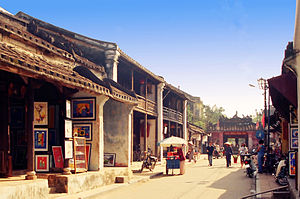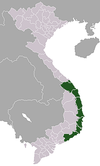Hội An: Difference between revisions
Dr. Blofeld (talk | contribs) No edit summary |
No edit summary |
||
| Line 171: | Line 171: | ||
*[http://artific.org/stikkord/hoi+an Pictures from Hoi An] |
*[http://artific.org/stikkord/hoi+an Pictures from Hoi An] |
||
*[http://www.socher.org/gallery2/v/Vietnam/4+a+Hoi+An/ 185 recent photos from Hội An] |
*[http://www.socher.org/gallery2/v/Vietnam/4+a+Hoi+An/ 185 recent photos from Hội An] |
||
*[http://www.lotussiatravel.com/vietnam+hotels/hoian+hotels Hội An Hotels] |
|||
{{coord|15.877098|108.325801|format=dms|display=title|type:city}} |
{{coord|15.877098|108.325801|format=dms|display=title|type:city}} |
||
Revision as of 12:02, 25 March 2009
- for the commune in An Giang Province see Hội An, An Giang
Hội An | |
|---|---|
Provincial City | |
| Thành phố Hội An | |
 A view of the old town | |
| Country | |
| Province | Quang Nam Province |
| Area | |
| • Total | 60 km2 (20 sq mi) |
| Population | |
| • Total | 121,716 |
| • Ethnicity | 90% East Asian (Vietnamese Chinese or Japanese) 9% European 1% Black |
Hội An is a small city on the coast of the South China Sea in the South Central Coast of Vietnam. It is located in the Quảng Nam province and is home to approximately 88,000 inhabitants.
The city possessed the largest harbour in Southeast Asia in the 1st Century and was known as Lâm Ấp Phố (Champa City).

The former harbour town of the Champa people at the estuary of the Thu Bon river was an important Vietnamese trading centre in the 16th and 17th centuries, where Chinese from various provinces as well as Japanese, Dutch and Indians settled. During this period of the China trade, the town was called Hai Pho (Seaside Town) in Vietnamese. Originally Hai Pho was a divided town with the Japanese settlement across the "Japanese Bridge"(16th-17th century). The bridge (Chùa cầu) is a unique covered structure built by the Japanese, the only known covered bridge with a Buddhist pagoda attached to one side.
The town is known to the French and Spanish as Faifo, and by similar names in Portuguese and Dutch. A number of theories have been put forth as to the origin of this name. Some scholars have suggested that it comes from the word "hải-phố" (海浦) meaning "sea town", while others have said that it is more likely simply a shortening of Hội An-phố (會安浦), "the town of Hoi An", to "Hoi-pho" which became "Faifo".[1]
In 1999, the old town was declared a World Heritage site by UNESCO as a well-preserved example of a Southeast Asian trading port of the 15th to 19th centuries, with buildings that display a unique blend of local and foreign influences.
Today, Hội An is still a small city, but it attracts a fair number of tourists, also being a well-established place on the backpacker trail. Many visit for the numerous art and craft shops and tailors, who produce made-to-measure clothes for a fraction of the western price.[2] Several Internet cafés, bars and restaurants have opened along the riverfront. Hoi An is famed for its centuries old Cao lầu noodle, which can only be uniquely served here.
History
Hoi An was founded as a trading port by the Nguyen Lord Nguyen Hoang sometime around 1595. The Nguyễn Lords were far more interested in commercial activity than the Trịnh Lords who ruled the north. As a result, Hoi An flourished as a trading port and became one of the most important trade ports on the South China Sea. Captain William Adams, the famous English sailor and confidant of Tokugawa Ieyasu, is known to have made at least one trading mission to Hoi An (around 1619).
In the 1700s Hoi An was considered by some Chinese merchants to be the best destination for trading in all of South East Asia.[3] However the importance of Hoi An declined sharply at the end of the 1700s due to the collapse of the Nguyen rule (thanks to the Tay Son Rebellion - which was opposed to foreign trade). Then, with the triumph of Emperor Gia Long, he repaid the French for their aid by giving them exclusive trade rights to the nearby port town of Da Nang. Da Nang became the new center of trade (and later French influence) in central Vietnam while Hoi An was a forgotten backwater. Local historians also say that Hoi An lost its status as a desirable trade port due to silting up of the river mouth.
The result was the Hoi An remained almost untouched by the changes to Vietnam over the next 200 years (somewhat reminiscent to the famous walled city of Carcassonne in southern France).
Museums
| UNESCO World Heritage Site | |
|---|---|
 | |
| Criteria | Cultural: ii, v |
| Reference | 948 |
| Inscription | 1999 (23rd Session) |
The city has various small museums highlighting the history of the region, especially ceramics:
Notable people
- Trần Thị Thùy Dung (1990-) - Miss Vietnam
Images

References
See also


